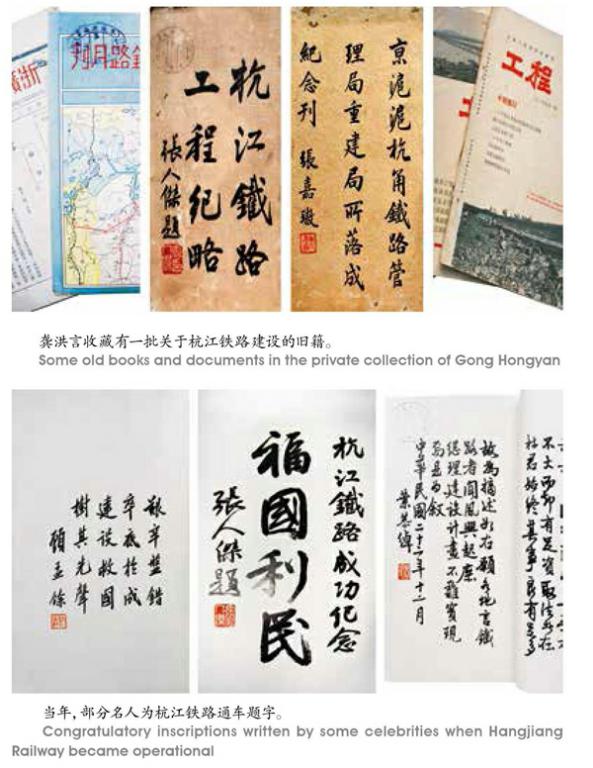望不断杭江铁路的烟云
2017-09-14巫少飞徐青
巫少飞?徐青
衢州市民龚洪言先生收藏有一批关于中国铁路建设的旧籍,笔者花些时日翻检,结合查阅江山市档案局档案、走访江山站铁路老员工,梳理出一些正在被人渐渐遗忘的杭江铁路的史迹。
杭江铁路曾是打开浙、赣、湘三省关山隔阻的浙赣铁路的前身,为浙江现代文明发展做出过不少贡献,如今,部分遗址已被列为文物保护单位。
大长中国人的志气

龚先生收藏较多的是关于杭江铁路建设的书刊,具有很高的第一手文献价值,如《杭江铁路工程纪略》《浙赣铁路月刊》和《江西铁路百年图志》《南昌铁路局志》等。
1840年以还,有识之士开始“睁眼看世界”“师夷长技以制夷”,实业救国。1898年至1900年,有外国首先提出修筑浙江联通闽赣的铁路计划。1910年,浙江提出修筑东南铁道计划。辛亥革命后,孙中山亲自筹划全国交通建设,设想在上海、杭州之间建一个东方大港,再造一条铁路直通廣州。
1929年2月,浙江省政府会议议决,自行筹款修建杭州至江西玉山的铁路;6月,成立工程局;1930年3月,在萧山举行开工;1934年初,全线通车,成为中国第二条自建铁路、第一条省营铁路。
杭江铁路除加强杭州作为中心城市的地位外,更成为浙江新式交通从沿海平原向内陆山地纵深发展的标志,其直接和间接辐射的腹地更为宽广。杭江铁路线走向的规划,对今天仍具有一定的启迪。
杭江铁路筹备期间,因省库财力所限,“挫折丛生”,后采用“固本简末”的节约措施,工期短、费用省,开创了我国铁路建筑工期的新纪录。
据《杭江铁路工程纪略》记载,本路一度拟改萧常铁路,后以常山无水路交通,缺乏联络,又循原测旧线,经江山以玉山为终点,恢复原名杭江铁路。
杭江铁路终点在江西玉山,理应为杭玉铁路。杭江铁路的命名,原因就在于本路是由浙江省自行筹款兴筑的,“本路起自杭州,虽终点以兴水路运输联络关系,伸展至赣省之玉山,而江山实为本省沿边之一县,因定名为杭江铁路”。
杭江铁路通车后,声震海内外,大长了中国人的志气。接着,浙江、江西两省府、铁道部及银行又组织成立浙赣铁路联合公司,下设浙赣铁路局,继续向西修建,历时3年,这一全线1008公里的江南大动脉于1937年9月通车,杭江铁路正式更名为浙赣铁路。此际,由我国桥梁专家茅以升设计、中国人自行施工建造的第一座现代化桥梁——钱塘江大桥竣工,成为浙赣铁路的重要组成部分。由此,浙赣铁路的起点从萧山改为杭州。
沉闷环境中的成功之举
龚先生收藏的《杭江铁路工程纪略》一书,内容非常丰富,包括有《杭江铁路之缘起及沿革》《杭江铁路组织》《工程计划》《江山江桥工程》等15章。

该书有3篇序言。《序一》由被称“中国土木水利(交通)建设之父”“孙中山建国方略实践第一人”曾养甫所作。他写道:“杭江铁路为浙江省办工程……大部出自社会投资而无借用外资诸国。”
《序二》由时任浙江省建设厅厅长石瑛所作。《序三》由负责厅务的霍宝树所作。霍氏说:“余以为杭江铁路之倡议确系非常之举动,各项工程之设计又有非常之革新,在此沉闷环境之今日,不能不认为非常之成功。”
龚先生还收藏有中国工程学会会刊《工程》,时间跨度为1933年至1936年。该刊在“桥梁及轮渡专号”中,有支秉渊、魏如合写的《杭江铁路金华桥及东迹桥施工纪实》,吴祥麒写的《杭江铁路江山江桥》等文章。
该刊在“钱塘江大桥工程专号”中,首篇即刊载茅以升《钱塘江桥一年施工之经过》一文。
此外,龚先生还收藏有《浙江省杭江铁路规章汇编》《杭江铁路行车时刻表》《浙江省杭江铁路行车规章》等,有从旁参证的价值。
龚先生收藏有《杭江小历纪程》《浙东景物记》等杭江铁路沿线导游指南之类的小册子,保留了当年的风物景象,并且不乏文艺佳作。
1933年底,杭江铁路试通车,铁路局邀请作家郁达夫、傅东华,学者陈万里,摄影家郎静山等人游历,经兰溪到龙游、衢州、江山以及江西玉山采风。郁氏写了《龙游小南海》《烂柯纪梦》《仙霞纪险》诸文,傅氏写了《杭江之秋》,陈氏写了《杭江缫记》,郎氏拍了不少风光照。
1937年9月浙赣铁路建成后不久,抗战烽火燃烧浙江大地。据江山市档案馆有关档案记载,浙赣铁路对于初期抗战贡献极大,向前方输送了大批兵员、战马、军粮、被服和枪械弹药等。另外,所有从津浦、京沪、沪杭、萧甬以及南浔等铁路撤退下来的各种设备、材料、物资,无不经由浙赣铁路抢运到后方。浙赣铁路在中国抗战史上留下了浓墨重彩的一笔。
杭州沦陷前夕,国民政府令部队将钱塘江大桥及各段线路逐步破坏。至抗日战争胜利时,仅存杭州至诸暨、江山至上饶两段线路通车。1946年开始修复,1948年12月全线重新通车。
边区岩邑的崛起
民国时期所修《江山史稿》记载:“江山原为浙江省边区岩邑,自……杭江铁路过本邑,至江西玉山,形势大变,一跃而成为华东大都会矣。”
1933年11月16日,首列火车驶过江山;12月28日,杭江铁路全线贯通。1934年元旦,江山正式通客车。
杭江铁路江山境内工程用时仅13个月,速度惊人。当时,江山民众参与热情极高,同意低价出让土地或无偿捐献。收买土地的价格是由县政府组织评价委员会分级拟定,呈报省政府核准实施。
江山境内最大、最难的工程为建造江山桥。桥建于航头村,因而也称航头大桥,为整条杭江铁路跨度最长的桥梁。“十月十九日铺轨至江山桥右岸,该桥为本路困难桥工之一,完成有待不得已,乃搭架临时便桥,日夜钻赶,凡七日而便桥告成,得以安然试车通过。”endprint
杭江鐵路在江山境内全长40公里,通车后,沿线乡镇纷纷崛起,从而整体上改变了浙江中西部地区城市布局与兴衰更替。据记载,江山运出的有粮食、木材、毛竹等;贺村是有名的“牛墟”,“那时有整火车皮的牛运向外地,猪也有”;上塘有兴盛的水泥行业。江山确立了在福建、江西、浙江交界地区的经贸中心地位,而贺村则很快成为三省货运集散中心。
在阅读了龚先生的旧藏后,笔者又采访了铁路江山站原站长周樟树先生,了解浙赣铁路后来的情况。
最后的绿皮车厢
周先生于1969年进入铁路行业,从贺村站的装卸工、扳道工开始,先后又在新塘边站、上铺站、江山站工作,2008年在江山站站长任上退休。
周先生说,上世纪70年代中期,贺村站主要以货运为主,每天有4趟列车经过,因为在80年代中期前,浙赣铁路一直是单线的,而江山到杭州需要运行10个小时左右。后来,“列车增至每天6趟以上”。“80年代后期铁路改建后,经过的车次至少在10趟以上。到了90年代初,仅上铺站,每月装车3000多车次,卸车1000多车次。之后,江山站慢慢地以客运为主。自2000年起,客运占70%以上。”
火车从蒸汽机车、内燃机车再到电动机车的发展经历,周先生全程目睹:从江山到杭州只要运行1个多小时。他回忆了一些情况:“1969年,江山到杭州的车票是5毛钱左右;80年代,4块2毛;90年代初,绿皮车24块、红皮车41块;如今,动车83块、高铁123块5毛。”“我清楚地记得,坐火车最拥挤的时候有两段,一是‘文化大革命红卫兵串联,二是2000年前后的春运。”“那两段时间客车每节车厢上300多人。2000年春运,江山站最多一天有1万多人上车。”
采访行将结束,周先生带着笔者一行看了停放在江山西山公园里最后的两节火车绿皮车厢,车厢外还保留着“江山——北京”的字样。周先生说:“大约2005年,上海铁路局专门赠送给江山市两节绿皮车厢作为纪念——在原江山站未拆之前,就事先保留一截铁轨,并把车厢运送进来。”
“江山站是一个三等站,可从江山始发的列车有8趟之多,现在可能有10多趟了,其中有一趟开往北京。”谈及铁路江山站,周先生很是自豪,“客车从江山站始发,大约因为这是上海铁路局管辖范围的最后一站。江山站以前属于南昌铁路局,上世纪70年代中期才划入上海铁路局,成为两个路局的分界站。”
如今,这两节绿皮火车车厢仍在发挥着作用。年轻人拍婚纱照,总爱以此为背景;而怀旧的人来到这里,心绪总能飘得很远很远……
(本文图片由作者提供)
From the private collection of books by a man named Gong Hongyan in Quzhou, the missing pieces of the jigsaw of the Chinese rail history are emerging. The pieces form part of the overall picture of Hangjiang (Hangzhou-Jiangshan) Railway, the prototype of Zhejiang-Jiangxi Rail that ended the geographical separation between Zhejiang, Jiangxi and Hunan provinces for the first time in the rail transportation history of China. The old railway has long since retired. The remains of the railway are now under provincial-level cultural protection.
Most books in Gongs collection are about the construction of the historical railway, and therefore provide valuable information for historians. The idea of connecting Zhejiang with neighboring Jiangxi and Fujian provinces by railway was first initiated by foreigners during the period from 1898 to 1900. After the Revolution of 1911, Dr. Sun Yat-sen proposed a national transportation construction plan that included the ambition of building a major port between Shanghai and Hangzhou and a railway connecting Zhejiang with Guangzhou Province via Jiangxi and Hunan.
The construction of the section between Hangzhou and Yushan in Jiangxi started in March, 1930. The rail went operational at the beginning of 1934 as the second one in China to have been constructed single-handedly by the Chinese people and as the countrys first railway managed by the provincial rail authority.endprint
The railway not only reinforced the strategic importance of Hangzhou as the provinces core city, but also marked the start of Zhejiang Provinces new rail transportation reaching the vast inland.
The construction of the railway also set a brilliant example of record-breaking high efficiency and cost management. As recorded in one of the books, the construction plan changed to try Changshan as the destination, but Yushan was chosen as the end of the passage because of high difficulty level due to lack of waterway transportation.
Following the successful launch of Hangjiang Railway, construction of a series of rail projects started, further expanding the influence of this ‘Jiangnan artery in Jiangxi and Zhejiang. In the fall of 1937, a 1,008-km-long ‘artery, renamed Zhejiang-Jiangxi Rail, opened fully to traffic. Chinas first truly modern bridge, designed by Mao Yisheng, became a significant part of the rail network. Hangzhou replaced Xiaoshan as the starting point of this new transportation lifeline.
Gongs collection of historical records also includes a lot of well-illustrated tourist handbooks that provide todays people with eye-opening information about the railways past.
In commemoration of the trial opening of the railway, the railway authorities invited such famous writers as Yu Dafu and Fu Donghua, scholars, and photographer Lang Jingshan to take the train and travel in Longyou, Quzhou, Jiangshan and Yushan. The result was a cycle of literary works and a good many pictures that have become an important footnote to the forgotten glory of the railway.
Zhejiang was engulfed in the warring flames soon after the launch of the railway. The railway wrote a key chapter in the history of Chinas resistance war against Japanese aggression. Repair work of the wrecked railway started in 1946, and in December of 1948 it was reopened to traffic.
The railways 40-km-long section in Jiangshan brought substantial changes to the urban development of the middle and western parts of Zhejiang Province. The opening of the railway was soon followed by the bustling trade of cattle, foodstuff and cement in Hecun and Shangtang, making the former a distribution center serving cattle dealers in three provinces.
A talk with Zhou Zhangshu, former director of the Jiangshan Railway Station, revealed a lot of interesting facts known to very few.
“The ticket started from 0.5 yuan in 1969 to 4.2 yuan in the 1980s and 24 yuan for standard seats in early 1990s,” he recalled.
He still remembers clearly the two most unbearable experiences of traveling in a sardine can: one was in the Cultural Revolution period and the other around the Spring Festival of 2000.endprint
